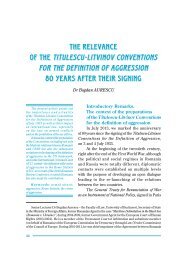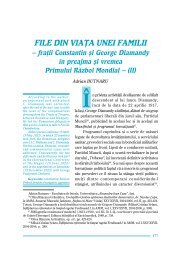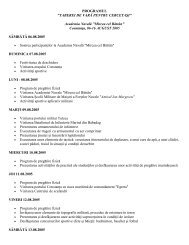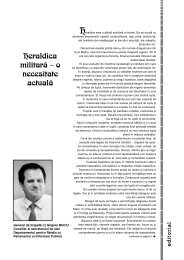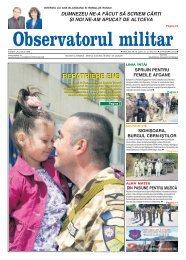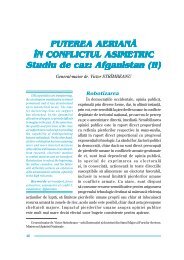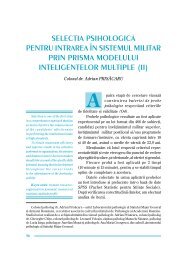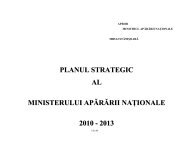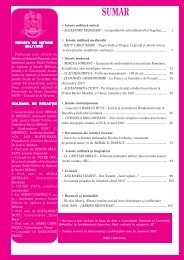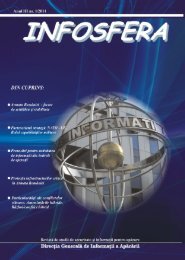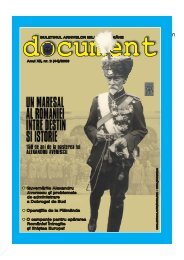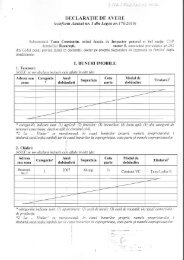Romanian Military Thinking
Romanian Military Thinking
Romanian Military Thinking
Create successful ePaper yourself
Turn your PDF publications into a flip-book with our unique Google optimized e-Paper software.
Opinions • Arguments • Certitudes • Perspectives<br />
is Arthashastra 23 that presents a method,<br />
an algorithm to choose the general strategic<br />
options (which represents more than<br />
a military strategy), respectively to choose<br />
a policy depending on the ratio of forces,<br />
the period of waiting after war or peace,<br />
the negotiations after war or peace etc.<br />
After the great discoveries in the<br />
19 th century, modern combat means have<br />
appeared and “the battle becomes a matter<br />
of both capitalising on the own potential<br />
and immediately exploiting the enemy<br />
vulnerabilities that have to be properly known<br />
in advance and taken advantage of” 24 .<br />
Jomini writes that the transition from<br />
politics to war is a combination “by which<br />
a statesman must judge when a war is<br />
convenient, timely, even indispensable and<br />
to determine the different operations necessary<br />
to achieve the objective” 25 . He also says that<br />
military art has five main branches: strategy,<br />
great tactics, logistics, detailed tactics<br />
and the engineering art, which means that,<br />
in accordance with the results of our<br />
research, military art is a military science,<br />
better to say, one of the military sciences.<br />
Analysing the contemporary military<br />
phenomenon, we have come to the following<br />
conclusions:<br />
the contemporary military<br />
phenomenon represents more than warfare<br />
or armed combat;<br />
the armed combat, warfare’s central<br />
domain, is studied, from the social<br />
perspective, by a distinct science, military<br />
sociology, which is a border science;<br />
the contemporary warfare is more<br />
than armed combat and needs a thorough<br />
approach;<br />
peace is not achieved only by<br />
civilians but also by the military, through<br />
peacekeeping operations;<br />
many sciences study different subjects<br />
even during the war or military action, which<br />
has led to the appearance of new branches<br />
that overlap the study subject of the science<br />
that studies the military phenomenon<br />
or armed combat.<br />
Therefore, there are sciences that<br />
study the military action and have war as<br />
their subject, others that study the armed<br />
forces action for social peace and stability<br />
and others that examine the influence<br />
of the geographic space on the policies<br />
in the military field and on the military<br />
phenomenon. There are others that analyse<br />
human psychology on the battlefield and<br />
the relationships between civilians and the<br />
military in peacetime, during crisis and<br />
at war and sciences that study the combat<br />
means utilized in the military action etc.<br />
If we analyse each military science,<br />
we can see that they have a subject,<br />
a scientific research methodology,<br />
a minimum number of hypotheses, theories,<br />
laws or principles according to which the<br />
examined phenomenon is explained,<br />
as well as a practical application of theory.<br />
Therefore, there is not only one but several<br />
sciences that study the military domain,<br />
fact that emphasizes the idea that there are,<br />
indeed, military sciences.<br />
23 Chaliand Gerard, Anthologie mondiale de la stratégie. Des origins au nucléaire, Edition Robert<br />
Laffont, S.A., Paris, 1990, p. 408.<br />
24 Popescu Mihail [.a., op. cit., p. 42.<br />
25 Chaliand Gerard, op. cit., p. 42.<br />
57



